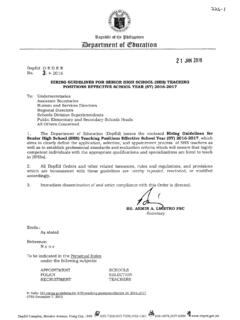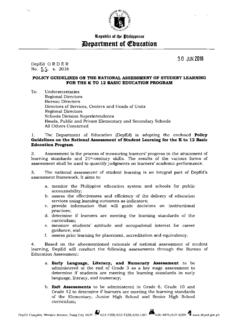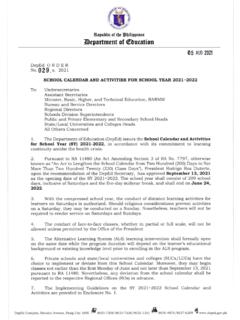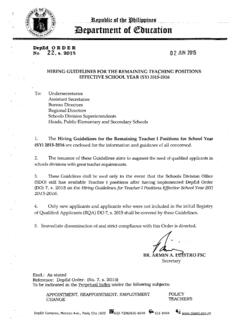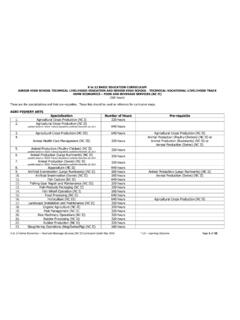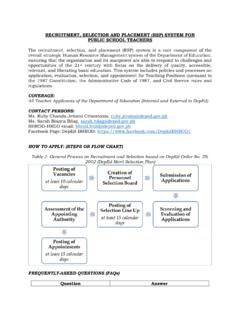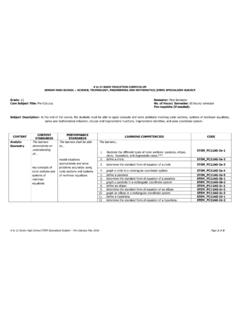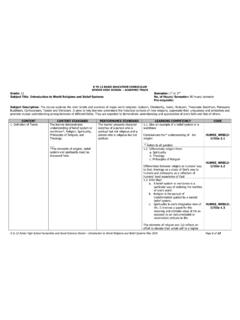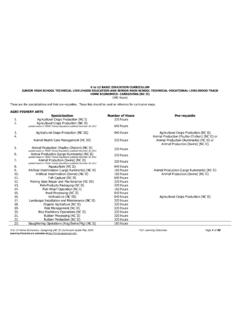Transcription of K to 12 Curriculum Guide - deped.gov.ph
1 Republic of the Philippines Department of Education DepEd Complex, Meralco Avenue Pasig City K to 12 Curriculum Guide SCIENCE. (Grade 3 to Grade 10). August 2016. K to 12 BASIC EDUCATION Curriculum . CONCEPTUAL FRAMEWORK. Science education aims to develop scientific literacy among learners that will prepare them to be informed and participative citizens who are able to make judgments and decisions regarding applications of scientific knowledge that may have social, health, or environmental impacts. The science Curriculum recognizes the place of science and technology in everyday human affairs. It integrates science and technology in the social, economic, personal and ethical aspects of life. The science Curriculum promotes a strong link between science and technology, including indigenous technology, thus preserving our country's cultural heritage. The K to 12 science Curriculum will provide learners with a repertoire of competencies important in the world of work and in a knowledge-based society.
2 It envisions the development of scientifically, technologically, and environmentally literate and productive members of society who are critical problem solvers, responsible stewards of nature, innovative and creative citizens, informed decision makers, and effective communicators. This Curriculum is designed around the three domains of learning science: understanding and applying scientific knowledge in local setting as well as global context whenever possible, performing scientific processes and skills, and developing and demonstrating scientific attitudes and values. The acquisition of these domains is facilitated using the following approaches: multi/interdisciplinary approach, science- technology-society approach, contextual learning, problem/issue-based learning, and inquiry-based approach. The approaches are based on sound educational pedagogy namely, constructivism, social cognition learning model, learning style theory, and brain-based learning.
3 Science content and science processes are intertwined in the K to 12 Curriculum . Without the content, learners will have difficulty utilizing science process skills since these processes are best learned in context. Organizing the Curriculum around situations and problems that challenge and arouse learners' curiosity motivates them to learn and appreciate science as relevant and useful. Rather than relying solely on textbooks, varied hands-on, minds-on, and hearts-on activities will be used to develop learners'. interest and let them become active learners. As a whole, the K to 12 science Curriculum is learner-centered and inquiry-based, emphasizing the use of evidence in constructing explanations. Concepts and skills in Life sciences , Physics, Chemistry, and Earth sciences are presented with increasing levels of complexity from one grade level to another in spiral progression, thus paving the way to a deeper understanding of core concepts.
4 The integration across science topics and other disciplines will lead to a meaningful understanding of concepts and its application to real-life situations. K to 12 Science Curriculum Guide August 2016 Page 2 of 203. Learning Materials and equipment technical specifications may be accessed at *These materials are in textbooks that have been delivered to schools. K to 12 BASIC EDUCATION. Scientific, Curriculum . Technological and Environmental Literacy Developing and Demonstrating Scientific Attitudes and Values Brain-based learning The Conceptual Framework of Science Education K to 12 Science Curriculum Guide August 2016 Page 3 of 203. Learning Materials and equipment technical specifications may be accessed at *These materials are in textbooks that have been delivered to schools. K to 12 BASIC EDUCATION Curriculum . CORE LEARNING AREA STANDARD: (SCIENCE FOR THE ENTIRE K TO 12). The learners demonstrate understanding of basic science concepts and application of science-inquiry skills.
5 They exhibit scientific attitudes and values to solve problems critically, innovate beneficial products, protect the environment and conserve resources, enhance the integrity and wellness of people, make informed decisions, and engage in discussions of relevant issues that involve science, technology, and environment. KEY STAGE STANDARDS: (STANDARDS FOR SCIENCE LEARNING AREAS FOR K-3, 4-6, 7-10 AND 11-2). K 3 4 6 7 10 11-12. At the end of Grade 10, the learners should have developed scientific, technological, and At the end of Grade 12, the learners At the end of Grade 3, the At the end of Grade 6, the learners environmental literacyand can make that should have gained skills in obtaining learners should have acquired should have developed the essential would lead to rational choices on issues scientific and technological information healthful habits and skills of scientific inquiry designing confronting them. Having been exposed to from varied sources about global havedeveloped curiosity about simple investigations, using appropriate scientific investigations related to real life, issues that have impact on the self and their environment procedure, materials and tools to gather they should recognize that the central feature country.
6 They should have acquired using basic process skills of evidence, observing patterns, of an investigation is that if one variable is scientific attitudes that will allow them observing, communicating, determining relationships,drawing changed (while controlling all others), the to innovate and/or create products comparing, classifying, conclusions based on evidence, and effect of the change on another variable can useful to the community or country. measuring, inferring and communicating ideas in varied ways to be measured. The context of the investigation They should be able to process predicting. This curiosity will make meaning of the observations can be problems at the local or national level information to get relevant data for a help learners value science as and/or changes that occur in the to allow them to communicate with learners problem at hand. In addition, learners an important tool in helping environment.
7 The content and skills in other parts of the Philippines or even from should have made plans related to them continue to explore their learned will be applied to maintain good other countries using appropriate technology. their interests and expertise, with natural and physical health, ensure the protection and consideration forthe needs of their environment. This should also The learners should demonstrate an improvement of the environment, and community and the country to include developing scientific practice safety measures. understanding of science concepts and apply pursue either employment, knowledge or concepts. science inquiry skills in addressingreal-world entrepreneurship, or higher education. problems through scientific investigations. K to 12 Science Curriculum Guide August 2016 Page 4 of 203. Learning Materials and equipment technical specifications may be accessed at *These materials are in textbooks that have been delivered to schools.
8 K to 12 BASIC EDUCATION Curriculum . GRADE/LEVEL Grade-Level Standards The learners will demonstrate an emerging understanding of the parts of their body and their general functions; plants, animals and varied materials in their environment and their observable characteristics; general weather conditions and how these influence what they wear; and Kindergarten other things in their environment. Understanding of their bodies and what is around them is acquired through exploration, questioning, and careful observation as they infer patterns, similarities, and differences that will allow them to make sound conclusions. At the end of Grade 1, learners will use their senses to locate and describe the external parts of their body; to identify, external parts of animals and plants; to tell the shape, color, texture, taste, and size of things around them; to describe similarities and differences given two objects; to differentiate sounds produced by animals, vehicles cars, and musical instruments; to illustrate how things move; to, describe the weather and Grade 1.
9 What to do in different situations; to use appropriate terms or vocabulary to describe these features; to collect, sort, count, draw, take things apart, or make something out of the things; to practice healthy habits ( , washing hands properly, choosing nutritious food) and safety measures ( , helping to clean or pack away toys, asking questions and giving simple answers/ descriptions to probing questions). At the end of Grade 2, learners will use their senses to explore and describe the functions of their senses, compare two or more objects and using two or more properties , sort things in different ways and give a reason for doing so, describe the kind of weather or certain events in the Grade 2 home or school and express how these are affecting them, do simple measurements of length, tell why some things around them are important , decide if what they do is safe or dangerous; give suggestions on how to prevent accidents at home, practice electricity, water, and paper conservation, help take care of pets or of plants , and tell short stories about what they do, what they have seen, or what they feel.
10 At the end of Grade 3, learners can describe the functions of the different parts of the body and things that make up their surroundings --- rocks and soil, plants and animals, the Sun, Moon and stars. They can also classify these things as solid, liquid or gas. They can describe how objects Grade 3 move and what makes them move. They can also identify sources and describe uses of light, heat, sound, and electricity. Learners can describe changes in the conditions of their surroundings. These would lead learners to become more curious about their surroundings, appreciate nature, and practice health and safety measures. At the end of Grade 4, learners can investigate changes in some observable properties of materials when mixed with other materials or when force is applied on them. They can identify materials that do not decay and use this knowledge to help minimize waste at home, school, and in the community. Learners can describe the functions of the different internal parts of the body in order to practice ways to maintain good health.

